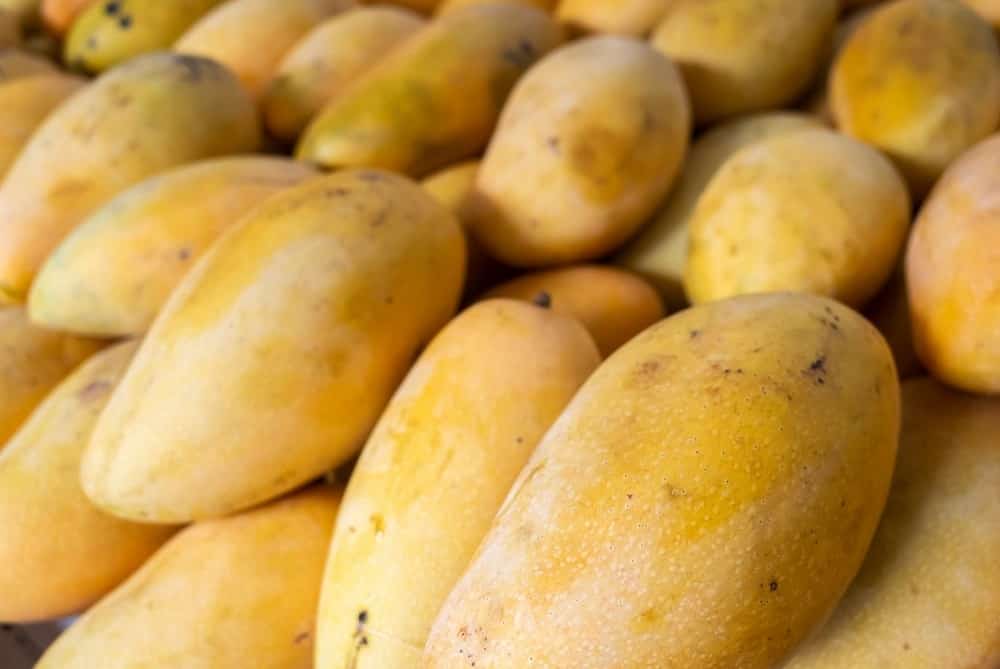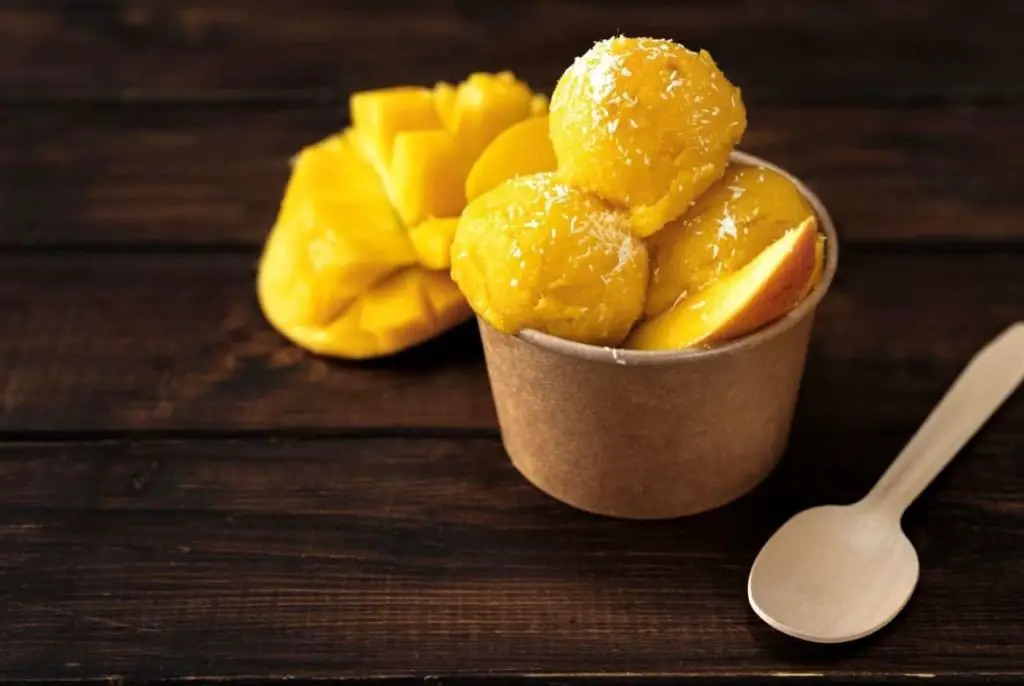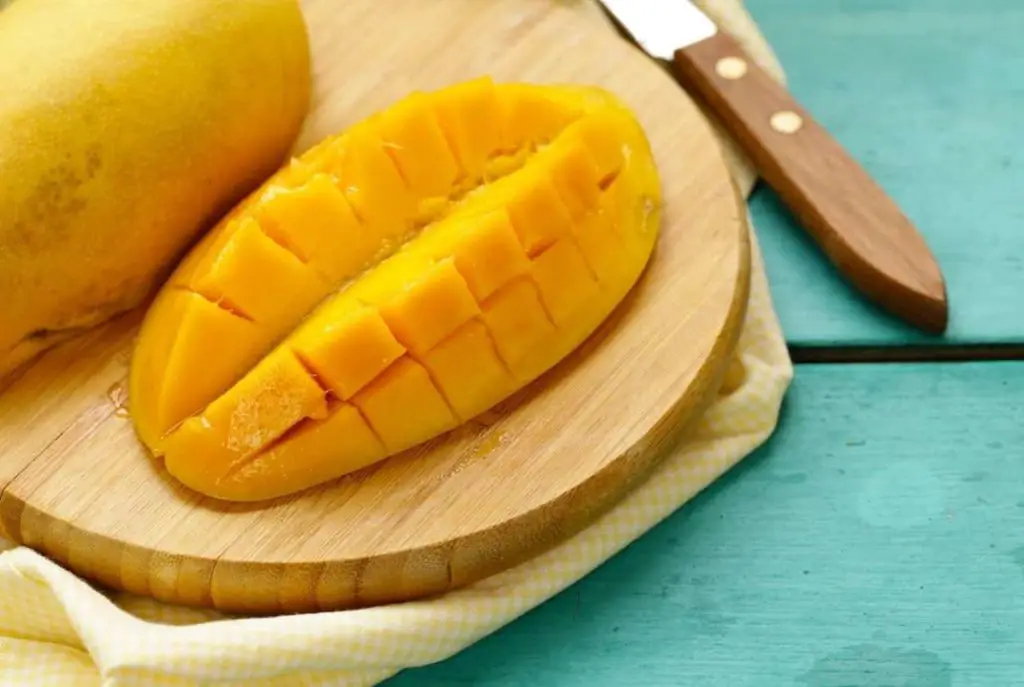Mangoes are packed full of goodness, but like most stone fruits, they don’t last long.
It can also be unpredictable when they’re likely to go off, as it depends on the individual fruit, and how fresh it was when you bought it.
When you can get them in season, they are at their juiciest, biggest, and they are also substantially cheaper than if you were to buy them later on in the year.

Or, you may be lucky enough to be able to grow your own mangoes, and the weather has meant that you’ve got a lot more than normal, and now you’re wondering what to do with them.
You’ve probably noticed that you can buy frozen mango from many supermarkets, so you know it’s possible to freeze them (see also Can You Freeze Melon?).
And the good news is that you can do so without needing any specialist equipment. You just need a freezer.
Read on to discover the different ways to freeze mangoes, what method of defrosting would suit you best, how you can use thawed mangoes, and how the process of freezing and thawing changes the fruit.
Should You Freeze Mangoes?
The process of freezing and thawing food is a tough one for food to go through, and it often alters the consistency and the flavor of the end result, though that might be minimal, or very noticeable.
When it comes to mangoes, the freezing and thawing process makes the fruit lose some of its structure (similarly to Freezing Cantaloupes), making it a little more mushy than fresh mango.
If you’re planning on using thawed mango in something like a fruit salad, or in yogurt – anything that calls for fresh fruit, be sure to strain the excess liquid first, otherwise whatever you make will end up watery.
Whether you want to use thawed mangoes as is entirely depends on your preference. For some, the texture is a deal-breaker, it’s not for everyone.
In which case, some people avoid freezing it altogether, or using thawed mango in salads or yogurt.
If you find that’s true for you, you can still use it in cooking or baking without any problems.
How Do You Freeze Mango?
How To Prepare Mangoes For Freezing
The first thing you want to make sure is that the mango is completely ripe. Freezing a mango which isn’t ripe won’t end well, and you can bet it won’t ripen in the freezer.
The best way to tell if a mango is ripe is to squeeze it gently. It should give a little under your fingers, but not too much, similar to how a perfectly ripe nectarine (see also Can You Freeze Nectarines) or avocado does.
Only choose mangoes that aren’t bruised or otherwise damaged, and this will help make sure that when you’ve defrosted the mango, it’s at the best it can be.
Remember that most mangoes, once they’re ripe, aren’t one solid color, so don’t judge the ripeness of the fruit based on the skin’s color.
There are several ways to freeze mango, and which one you might go for will probably depend on your preferences, what you want to use it for, and how much time you have.
If you’re not sure which one to go with, or what you’ll use the mango for when you come to defrost it, go for the first option.
It’s also the fastest method, but it won’t keep as well for a prolonged period of time in the freezer.
If you want to freeze mangoes for a long time, freezing them in sugar syrup will help retain the fruit’s structure. The end result will be a little sweeter, though, so keep this in mind. You may have to alter an end recipe to account for this.
If you plan on using the mangoes in smoothies, puréeing them and then freezing them is the best option.
Freezing Chunks Or Slices Of Mango
This method has a great upside: you will only need to defrost as much as you need at once, eliminating the risk of food waste.
This also keeps your options open when it comes to using it – if you want to use it as is, great, if you want to purée it, you still have that option.
Slice the mango in half, and cut the flesh from the skin. How you then choose to slice or dice it is up to you.
If you’re not sure what to go with, cutting the mango into smaller cubes will work with pretty much anything you have in mind.
Get a baking tray, and line it with parchment paper, or a reusable liner. Place the pieces of mango in a single layer, making sure that they don’t touch.
Any mango pieces that touch will be frozen together. That’s fine for a few pieces, but it will up the defrosting time, and it can make portioning tricky.
Stick the whole tray into the freezer, and wait until they are solid.
Decant the frozen mango into a resealable freezer bag, making sure to label it, and squeeze out any excess air before sealing. Then you can put the bag straight into the freezer.

How To Freeze Mango In Syrup
Freezing mangoes in syrup is a little more time-consuming, but it’s a method worth doing if you want to preserve mangoes for a longer period of time.
It also helps to preserve the consistency of the mango, but if this isn’t something you absolutely need, you’re better off using a different method.
As you would for the first method, prepare the mango and cut the fruit into manageable chunks or slices.
Get some lukewarm water and some sugar, and mix them together until the liquid is transparent. You’ll need enough to completely cover the fruit.
Put the fruit into a rigid airtight container, and pour the syrup over it. Leave some room at the top for the liquid to expand. Label the lid.
Make sure the container is properly sealed, and pop it into the freezer, completely upright, at least until it freezes.
How To Freeze Puréed Mango
If you don’t have a lot of mangoes to freeze, but you don’t want to waste it, puréeing it before you freeze it is a great way to preserve it.
This is also the perfect method if you plan on using it in a blender, as it’ll be much easier to mix, especially if your blender isn’t that powerful.
Again, same as before, cut the mango into pieces. The smaller you make the mango pieces, the easier and faster it will be to purée them. Run it through the blender until it gets smooth and creamy.
Decant the mango purée into airtight containers, label them, and freeze them.
If you think you won’t use all the purée at once, consider freezing it into small portions, even using an ice cube tray to do so. You can always take more out of the freezer.
How To Thaw Frozen Mango
Just like freezing a mango, you have a few options when it comes to thawing it.
The first option available is to defrost it in the fridge. This is largely the best way to thaw anything, and though it does take longer, it means that there’s no risk of bacterial growth, and the texture of the mango will be better preserved.
If you don’t want to wait overnight for the mango to thaw, you can submerge the container or bag in cold water. This will speed up the thawing process. It could take as little as an hour, or about 4 in total.
In some cases, you don’t have to defrost mango at all. This especially applies to smoothies or cooking dishes. Frozen mango can replace the ice in a smoothie, and in cooking, just add a few minutes extra onto the total cooking time.
How Do You Use Thawed Mango?
You aren’t really limited to how you can use mango after you’ve frozen and defrosted it. One of the easiest ways is to throw it into a smoothie, where it will add some natural sweetness as well as a lot of goodness.
You can also use it in cooking. If you’re baking, definitely defrost it first, as the extra moisture could affect the end product. The slight changes in consistency won’t matter here, as you’re unlikely to notice.
Thawed mango also works well in cocktails (see also Freezing Lychees). Consider using it frozen to cut down on ice diluting your drink.
Salsa (see also Can You Freeze Salsa) is also a great option for using thawed mango. Just make sure you strain it first, as a soggy salsa is disappointing.
If you don’t fancy any of the above options, you can also use it on its own, in a yogurt, paired with ice cream, or put it in a fruit salad.
Make sure to drain away the excess moisture and the mango is fully defrosted, and you’re good to go.
If you freeze the mango in syrup, this last option is the best way of using it, but keep in mind that the end result will be sweeter.

Conclusion
Mango is one of the most versatile fruits available, and if you can stock up on it when it’s in season, you’ll save quite a bit of money. This also goes for other fruit such as pineapple (see also Freezing Pineapple).
Freezing it is the best option when you want to stock up, as the changes are minimal, but the results are still superior to canned mangoes, giving you a better option for a prolonged shelf life.
It’s also better than buying it out of season, as the fruit will generally be much tastier, more nutritious, and it also reduces the ‘food miles’ of importing it, which helps everyone be a little greener, and reduces the carbon footprint.
